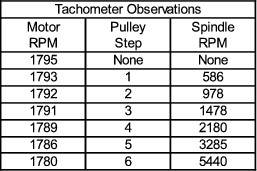


Fig. 2.1: Observed Spindle Speeds
Probably everybody starts out with a small split-phase AC motor similar to the Marathon 1/4hp model that is common with Taigs. All NEMA 48 frame motors, and old 56Z’s, have a 1/2” shaft which suits the bore of the Taig motor pulley. For a motor with a 5/8” shaft, it’s easy enough to just get another spindle pulley for it. The 1022 mounting bracket is designed for 48 frames but will accept 56s as well. I used an old Westinghouse 56Z which, I’m sure, worked as well as any. This motor, mount and belt tensioning system is not very sophisticated but, for the stock speed range, delivers quiet and dependable operation.
It is useful to understand exactly how this system works. Taig says a 1725rpm motor gives spindle speeds of 525 to 5200rpm. Fig. 2.1 shows the actual speeds I observed using a hand-held tachometer. These speeds are higher than Taig’s and part of the reason is that the motor is running 3-4% faster than 1725rpm. This turns out to be fairly normal. Fig. 2.2 shows the HP/Torque curve for a motor of this type and describes very closely the motor behaviour I observed. Furthermore, the graph suggests that it is very unlikely a Taig could ever impose enough load to slow this kind of motor down to 1725rpm.
The motor, however, is not the only factor involved. To slow Taig’s 1725rpm to 525rpm requires a reduction ratio of .304. But the facts show a reduction from 1793rpm to 586rpm, a ratio of .327. The difference has to be in the pulley system. Averaging the step diameters of several Taig pulleys yields the values shown in Fig 2.3. When adjusted for pitch diameter, the six resulting step pairs produce the drive ratios and calculated spindle speeds indicated. As you can see, these correspond closely to the actual observed speeds.
While the motor can deliver 1/4hp continuously, the belt system cannot. Consider Fig. 2.4 which is based on engineering data published by Gates and shows how power is handled by the 3M system. Their lowest entry is 500rpm so the shaded area contains my extrapolations assuming the declines continue at the same rate. Only the pulley sizes closest to the three smallest Taig steps are shown because they are part of all six ratios and, whether driving or driven, are always on the faster shaft which determines the power transmitted.
In normal use the Taig’s minimum spindle speed would likely run around 575rpm and deliver about .040hp. Clearly, the 1/4hp motor is chosen for its availabiliy and convenience and not its high power. Around this time I got interested in just how much horsepower was actually needed. Appendix A - Horsepower Calculations shows the results of my investigation for those who don’t mind a few equations.